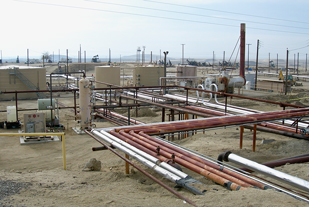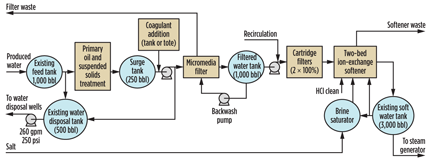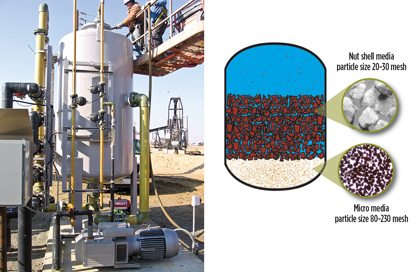|
KEITH JONES, Seneca Resources; MIKE DEJAK and GEORGE DI FALCO, Eco-Tec
Alternating between weak and strong cation exchange, the treatment system reduced hardness to less than 1 mg/L without the use of hazardous acid and caustic for softener regeneration.
As California entered a period of severe drought in 2008, the challenges of using thermal methods to extract heavy oil became compounded by the difficulty of securing freshwater sources from which to generate the high-quality steam that these methods require. In an effort to manage the crisis, then-Gov. Arnold Schwarzenegger proclaimed a state of emergency and enacted widespread water-conservation measures. The drought, which officially lasted until March 2011, impacted heavy oil fields in the state that rely on affordable fresh water to feed boilers in thermal techniques such as steamflooding and cyclic steam stimulation (CSS). Essentially, these thermal techniques involve the injection of steam into wells to heat the viscous oil to flowing temperatures. As the drought intensified in California, the prospect of feeding boilers with oilfield produced water instead was studied as an alternative.
One operator, Seneca Resources, found that it could no longer practically obtain the 7,000 bpd of fresh water it needed for its heavy oil operations in Bakersfield. Seneca, the exploration and production segment of Houston-based National Fuel Gas Company, develops oil and gas reserves in California and the Marcellus shale of Pennsylvania, and has been expanding into Kern County, California, since 1998. As a result of shortages in 2008 and 2009, Seneca was denied fresh California aqueduct water from the Lost Hills Water District and, instead, had to resort to purchasing its supply from farmers in the area. It became increasingly attractive to find a way to transition from fresh water to produced water for its steam production.
Using produced water to feed boilers is not a novel concept, but the much higher hardness and salinity of this water compared with fresh water can cause problems for operators, especially in thermal heavy oil applications, due to increased tendency toward scaling and corrosion in equipment. In order to make the transition, the operator needed a treatment system that could effectively filter and soften the high hardness and total dissolved solids (TDS) content of its produced water, and decided to employ an ion exchange-based softener that eliminated the need for acid and caustic often used for regeneration of produced water softeners.
TREATMENT SELECTION
At its plant in Lost Hills, California, the Seneca Resources’ once-through steam generator was producing 70% steam at 800 psig using fresh water, Fig. 1. The company was aware of the problems encountered by filtration and softening systems for treating produced water in thermal applications. If it was to integrate produced water into its extraction process, it needed a treatment system that could effectively filter and soften the high hardness of 446.7 mg/L as calcium carbonate (CaCO3) and high TDS (7,100.3 mg/L) that characterized produced water from its operations at a flowrate of about 7,000 bpd. The operator also had concerns regarding:
• Safety and costs related to handling acid and caustic often used for regeneration of produced water softeners
• High chemical (salt, acid and caustic) consumption due to the limitations of conventional ion-exchange softener designs, especially when treating produced water with high hardness or TDS
• Large waste volumes produced during regeneration, requiring disposal
• Large equipment, which requires considerable space and site assembly.
Among the most important concerns was the need to avoid the use of hydrochloric acid (HCl) followed by sodium hydroxide (NaOH), also known as caustic soda, which is commonly used to regenerate the resins in weak-acid-exchange (WAC) softeners. The operator did not want to add to its processes the costs and safety hazards related to the handling of these products, along with the need for corrosion-resistant alloys in construction of the processing equipment.
 |
|
Fig. 1. A complex network of pipes carries steam to and water from Seneca Resources’ heavy oil operations in Lost Hills, California.
|
|
Strong-acid-cation (SAC) ion-exchange processes employing only brine regeneration (i.e., no acid or caustic) are much simpler and less expensive than WAC processes. However, the SAC process is normally restricted to low-TDS waters (usually less than 3,000 mg/L, and sometimes up to 5,000 mg/L). WAC resins are normally used for softening high-TDS produced water, such as what the Seneca plant has to handle (about 7,100 mg/L).
In its investigation, Seneca looked at promising pilot plant testing results for a neighboring oil producer by design and manufacturing firm Eco-Tec, based in Pickering, Ontario, Canada. The company, which builds water, chemical and gas purification systems, was active in running pilots in the Bakersfield area using its RecoPur ion-exchange softeners. The system makes use of a novel ion exchange process, called Recoflo, which allows the use of either SAC or WAC resin to soften produced water at TDS levels up to 12,000 mg/L, to levels of residual hardness less than 0.1 mg/L. By using adequate dosages of high-purity brine, the company claimed its technology could eliminate the use of acid and caustic, even for regeneration of WAC resins. The company also indicated that its technology could provide 40%–80% reduction in salt and waste from regeneration compared with conventional softeners. These were critical factors for Seneca going into the project. The manufacturer also provided a micromedia pre-filtration system to reduce downstream softener fouling and associated problems.
The equipment was more compact and had a smaller footprint than competing systems. It’s fully automated design provided for simple operation, along with easy adjustment to variable feed water conditions and—if needed—effective in-situ resin cleaning.
The manufacturer designed a system for Seneca using data from a single freshwater analysis and several produced water analyses, Table 1. Based on the defined produced water characteristics, the system was designed to purify water to a total hardness of 1.0 mg/L as CaCO3 or less, at a product flowrate of 7,000 bpd. The new process was commissioned in December 2009, and startup took place within 10 days. While making use of some of the existing equipment and some auxiliary components, the new system replaced the previous gravity separators and clarification tank that Seneca was using to remove oil from produced water before sending it to a disposal well.
| Table 1. Analysis of Lost Hills produced water vs. previously used fresh water |
 |
TREATMENT PROCESS
The new produced water treatment process for steam generation is shown in Fig. 2. Primary oil and solids separation is accomplished using the pre-existing gravity separators (a series of skim tanks followed by a free-water knockout) and a refurbished induced gas flotation (IGF) cell.
 |
|
Fig. 2. Schematic of Seneca Resources’ new produced water treatment train for steam generation.
|
|
Micromedia filtration. Effluent from this treatment is stored in a surge tank and sent under pressure to the 60-in.-diameter micromedia filter, where remaining suspended matter and oil are removed. A coagulant is added as needed prior to the micromedia filter to aid in agglomeration of particles for effective filtration.
Removing suspended solids to 1 mg/L or less through some form of pretreatment is typically advised to ensure trouble free-operation of ion-exchange resin. If allowed to accumulate, these solids can adversely affect water and regenerant chemical distribution, which will ultimately increase the pressure drop across the ion-exchanger and degrade water quality and output volume. Furthermore, long-term fouling by solids can make subsequent resin cleaning much more difficult, if not impossible.
In the Seneca system, a specialty micromedia media filter called Spectrum is used to remove the residual oil and suspended solids remaining in the produced water after the IGF cell, Fig. 3. Typical oil and suspended solids levels in the feed were expected to be less than 3 mg/L and 10 mg/L, respectively, each with excursions as high as 70 mg/L. To produce the required softened water product flow of 7,000 bpd, a single 60-in.-diameter filter was selected.
 |
|
Fig. 3. To ensure proper operation of the ion-exchange softener, an upstream pretreatment stage consisted of a two-layer media filter, with an upper layer of coarse black walnut-shell media, followed by a lower layer of very fine, dense micromedia.
|
|
The two-layer filter has an upper layer of coarse (20–30-mesh) black walnut-shell media, followed by a lower layer of very fine, dense micromedia, and is designed to filter the produced water at high service flowrates. The top layer provides the bulk of solids retention and, therefore, defines the run length.
While dual-media filters typically employ silica sand with an effective size of about 0.35 mm as the fine media, the micromedia used in the Seneca plant has an effective size of less than 0.1 mm (80–230 mesh). This very fine, dense media acts as a polishing layer to remove the residual oil and solids that leak through the upper nutshell layer. The small particle diameter greatly decreases the size of pores and channels through the media, improving oil and solids capture efficiency. This also tends to increase the pressure drop across the media; however, the high operating temperature reduces viscosity, reducing the pressure drop to a range of 10–25 psig.
To ensure oil and solids removal, simultaneous air scour and backwash are used to agitate and wash the media. Air scour or backwash alone is inadequate since air alone does not lift and expand the media, but simply short-circuits through a few ratholes, leaving the majority of the media untouched. Backwash alone does not provide enough shear force to release the oil and solids from the media surface. Mechanical agitation effectively cleans the media, but is more costly and complex than the combined approach. In some cases, natural gas or nitrogen is used instead of air to avoid adding oxygen to the backwash wastewater. These are, of course, more expensive options and may not be warranted, since the impact of oxygen on vessel internal corrosion would be minimal and, if the waste is recycled, the amount of oxygen relative to the full produced water stream is small. In the Seneca installation, the filter is backwashed using filtrate.
The micromedia filter product flows to a filtered water tank, which is used as a source for backwash water. The filtered water is then sent under pressure through cartridge filtration to remove residual suspended solids. Cartridge filter elements provide a final polishing filtration to ensure that the feed water to the softener meets the equipment requirements.
Ion exchange. Finally, the cartridge filter outlet is sent through the salt-regenerated, dual-bed SAC/WAC ion-exchange softener. The ion-exchange beds are 42 in. in diameter and 6 in. and 3 in. in depth, for total volumes of 5 cu ft and 2.5 cu ft, respectively. They are mounted on a single frame and operate in series. After hardness present in the water is removed by ion exchange, the softened water is stored in a tank for use by the steam generators.
Use of fine-mesh resin (typically one-fourth the size of conventional beads) increases the rate of exchange, thus allowing the ion-exchange system to operate at a shallow bed depth and at high flowrates (30–50 gal/min. per sq ft), with the net effect of significantly smaller equipment compared to competitors. The resin bed is fully packed to allow counter-current regeneration, which minimizes regenerant consumption and optimizes product purity. However, because the resin is not fluidized during regeneration, care must be taken to properly filter all streams entering the resin bed. This is of particular importance when treating produced water because of concerns related to fouling by both particulates and oil.
Regeneration. The softener beds are simultaneously, counter-currently regenerated in series using high-purity, pressurized, saturated brine that meets the manufacturer’s hardness and filtration requirements. This brine is blended with softened water from the final storage tank. In some cases, a proprietary process called brine dehardener is recommended, which allows recycle of excess brine from regeneration of the secondary (i.e., polishing) softeners.
Fouling prevention. The manufacturer incorporated an in-situ resin cleaning process using citric acid. The process is performed weekly as a preventative measure to prevent iron fouling. Additionally, dosing of an anti-scalant chemical into the brine prevents precipitation of salts during regeneration.
Furthermore, a new cleaning process, developed by the manufacturer for use with short-bed technology, cleans the resin in situ by pumping in about one bed volume (5 cu ft for the Seneca unit) of a specialty short-bed cleaning solution. The oil is rapidly solubilized as the solution is pumped through the bed. The dirty cleaning fluid is displaced from the bed and, if desired, can be recovered for reuse, with the oil recycled upstream. The cleaning process itself can be accomplished in less than 30 min. To date, however, it has not been necessary to use this procedure at Seneca since resin cleaning has not been required.
PROGRESS SO FAR
Since commissioning in December 2009, the system has performed consistently to date. A water hardness level of less than 1 mg/L (as CaCO3) has been maintained, and additional field samples reveal product hardness levels of 0.2 mg/L, 0.33 mg/L and less than 0.13 mg/L. Pilot plant testing by the manufacturer has shown that maintaining hardness levels below 0.1 mg/L is possible.
Softener resin cleaning, as a response to resin fouling by oil and suspended solids, has not been needed in the more than 20 months since the system has started up. A fouling incident did occur shortly after commissioning when a large amount of emulsified oil was passed into the softener. During this period of about one day, the pressure drop across the unit rose as the oil accumulated on the resin. During this upset, the product hardness level was maintained below 1 mg/L without a reduction in run length. Flow through the unit was stopped, and the cartridge filters were changed. However, the resin columns were not opened and no cleaning procedure was undertaken. After the upset condition producing the emulsified oil was addressed, the softener was restarted and the pressure drop began to fall back to normal levels over a two-day period. It seems that the accumulated oil was simply washed off the resin by the warm produced water. To date, no other such upsets have been reported.
Prior to operating the new system, Seneca had experienced considerable operational challenges using fresh water to feed its boiler. The water coming out of the California aqueduct contained large quantities of algae and oxygen, which resulted in corrosion in both the steam generator and the downstream discharge piping. The corrosive dissolved oxygen in the fresh water—not present in produced water—frequently attacked the metal in the tubes of the generator and pipelines, forming iron oxide.
Because of the oxygen present in the fresh water, the Lost Hills plant regularly required servicing of the steam distribution system, specifically to the chokes that were clogging throughout its network of steam lines. Pigging the pipelines to clear out interference was a common practice when the previous system was in place. Screens were also used to protect the chokes from scale, and often the steam flow wouldn’t divert properly without the screens.
Despite switching to produced water, with its higher levels of hardness and TDS, operational challenges have been significantly reduced since the introduction of the new treatment system. For example, screens are no longer necessary to prevent scale from entering the chokes.
At the end of 2010, the consistent performance of the system prompted the operator to purchase another produced water purification system from the manufacturer for its slightly larger plant in Maricopa, California, where hardness levels in the produced water are higher. Startup is expected before the end of 2011. 
THE AUTHORS
|
| KEITH JONES is a Senior Technical Advisor for Seneca Resources in Bakersfield, California. He has spent 25 years working on heavy oil properties and holds a BS degree in petroleum engineering from the University of Wyoming. |
| |
| MIKE DEJAK is Executive Vice President of Eco-Tec, which he joined in 1974. He earned a BS degree in chemical engineering from the University of Toronto, holds a patent, and is the author of numerous technical papers and presentations. |
| |
| GEORGE DI FALCO is Marketing Communications Coordinator for Eco-Tec. He has authored various papers and articles on energy, manufacturing and environmental science. / gdifalco@eco-tec.com |
|






